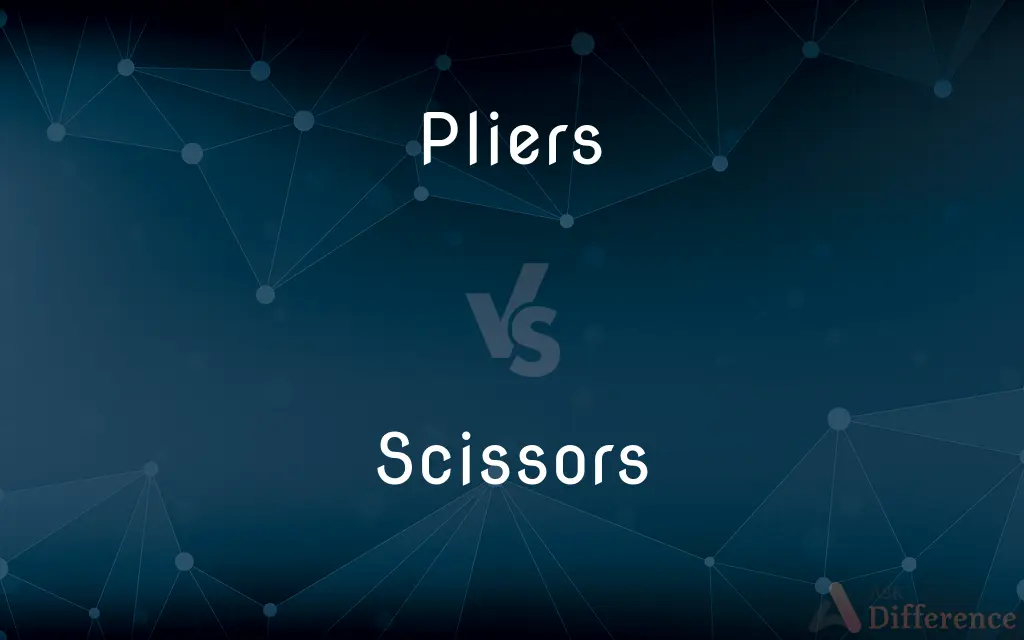Pliers vs. Scissors — What's the Difference?
Edited by Tayyaba Rehman — By Fiza Rafique — Updated on March 11, 2024
Pliers are designed for gripping and bending materials, while scissors are made for cutting.

Difference Between Pliers and Scissors
Table of Contents
ADVERTISEMENT
Key Differences
Pliers and scissors are both common tools but serve distinct purposes and exhibit different designs. Scissors, on the other hand, are specifically designed for cutting materials like paper, fabric, hair, and more.
Pliers are typically used for gripping, bending, or compressing various materials, making them indispensable in electrical, plumbing, and general repair work. Unlike pliers, which focus on the mechanical advantage for gripping or bending, scissors use two cross-blades sharpened on one side to slice through objects.
Pliers can also be adjusted or locked into position, providing a clamping function that can be very useful in holding objects securely while working on them. Scissors operate on a slightly different mechanical principle, where the force applied by the user's fingers is directly transferred to the cutting action at the blades.
Comparison Chart
Primary Use
Gripping and bending materials
Cutting materials
Design
Two metal pieces with jaws and handles
Two cross-blades connected at a pivot
ADVERTISEMENT
Variants
Needle-nose, slip-joint, locking, etc.
Tailor's shears, kitchen, safety, etc.
Mechanism
Leverage to increase grip/bend force
Direct force transfer for cutting
Material Handled
Wires, pipes, metal parts
Paper, fabric, hair
Compare with Definitions
Pliers
Gripping Tool.
The electrician used pliers to grip and twist the wires securely.
Scissors
Cutting Instrument.
She used sharp scissors to cut through the thick fabric effortlessly.
Pliers
Bending Device.
To shape the metal rod, she carefully used the pliers to make precise bends.
Scissors
Crafting Tool.
For his art project, he chose scissors to create intricate paper designs.
Pliers
Cutting Edge. Some pliers come with a cutting edge;
He snipped the wire using the cutting edge of his pliers.
Scissors
Hairdressing Essential.
The stylist used professional scissors to achieve the perfect haircut.
Pliers
Locking Mechanism.
The plumber locked the pliers onto the pipe to prevent it from turning.
Scissors
Kitchen Utensil.
She reached for the kitchen scissors to snip herbs directly into the pot.
Pliers
Adjustable Jaws.
With the adjustable jaws, the pliers could grasp objects of various sizes.
Scissors
Safety Design.
The children were provided with safety scissors to prevent accidents during craft time.
Pliers
Pliers are a hand tool used to hold objects firmly, possibly developed from tongs used to handle hot metal in Bronze Age Europe. They are also useful for bending and compressing a wide range of materials.
Scissors
Scissors are hand-operated shearing tools. A pair of scissors consists of a pair of metal blades pivoted so that the sharpened edges slide against each other when the handles (bows) opposite to the pivot are closed.
Pliers
Pincers with parallel, flat, and typically serrated surfaces, used chiefly for gripping small objects or bending wire
A pair of pliers
Scissors
To cut or clip with scissors or shears.
Pliers
One who plies a trade.
Scissors
Scissors (used with a sing. or pl. verb) A cutting implement consisting of two blades joined by a swivel pin that allows the cutting edges to be opened and closed.
Pliers
Pliers A variously shaped hand tool having a pair of pivoted jaws, used for holding, bending, or cutting.
Scissors
Any of various gymnastic exercises or jumps in which the movement of the legs suggests the opening and closing of scissors.
Pliers
A pincer-like gripping tool that multiplies the strength of the user's hand, often used for bending things.
I need a pair of pliers to get a good grip on that broken screw.
Scissors
A scissors hold.
Pliers
A kind of small pinchers with long jaws, - used for bending or cutting metal rods or wire, for handling small objects such as the parts of a watch, etc.
Scissors
A tool used for cutting thin material, consisting of two crossing blades attached at a pivot point in such a way that the blades slide across each other when the handles are closed.
Scissors are used to cut the flowers.
Use scissors to cut them if you don't have proper shears.
Pliers
A gripping hand tool with two hinged arms and (usually) serrated jaws
Scissors
A type of defensive maneuver in dogfighting, involving repeatedly turning one's aircraft towards that of the attacker in order to force them to overshoot.
Scissors
An instance of the above dogfighting maneuver.
Scissors
An attacking move conducted by two players; the player without the ball runs from one side of the ball carrier, behind the ball carrier, and receives a pass from the ball carrier on the other side.
They executed a perfect scissors.
Scissors
A method of skating with one foot significantly in front of the other.
Scissors
An exercise in which the legs are switched back and forth, suggesting the motion of scissors.
Scissors
A scissors hold.
Scissors
(rock paper scissors) A hand with the index and middle fingers open (a handshape resembling scissors), that beats paper and loses to rock. It beats lizard and loses to Spock in rock-paper-scissors-lizard-Spock.
Scissors
(rare) scissor
Scissors
(transitive) scissor
Scissors
(dated) Cry of anguish or frustration.
Scissors
A cutting instrument resembling shears, but smaller, consisting of two cutting blades with handles, movable on a pin in the center, by which they are held together. Often called a pair of scissors.
Scissors
And edge tool having two crossed pivoting blades
Scissors
A wrestling hold in which you wrap your legs around the opponents body or head and put your feet together and squeeze
Scissors
A gymnastic exercise performed on the pommel horse when the gymnast moves his legs as scissors move
Common Curiosities
Do pliers come with a locking mechanism?
Some pliers, like locking pliers, feature a mechanism to hold materials securely.
Can scissors be used on materials other than paper?
Yes, scissors can cut fabric, hair, cardboard, and other materials, depending on their design.
Are there specialized pliers for electrical work?
Yes, electricians often use needle-nose and wire-stripping pliers.
Can pliers be used to cut wires?
Yes, many pliers have a cutting edge designed for cutting wires.
What are the primary uses of pliers?
Pliers are mainly used for gripping, bending, and compressing materials.
Can all scissors cut through fabric?
Not all scissors are suited for fabric; tailor's scissors are specifically designed for cutting textiles.
What makes safety scissors safe for children?
Safety scissors have rounded tips and blades that cut paper but are less likely to cut skin.
How do I maintain my scissors to keep them sharp?
Clean them regularly and sharpen the blades as needed to maintain their cutting efficiency.
What's the difference between slip-joint and locking pliers?
Slip-joint pliers allow for adjusting the jaw size, while locking pliers can lock in place for a secure grip.
How do I choose the right scissors for crafting?
Look for scissors with sharp blades and a comfortable grip suitable for the material you're working with.
Are needle-nose pliers only used by electricians?
Needle-nose pliers are versatile and used in various fields, including jewelry making and mechanical work.
How do fabric scissors differ from regular scissors?
Fabric scissors have sharper blades and a specific angle for cutting textiles efficiently without fraying.
Why do some pliers have rubber handles?
Rubber handles provide a better grip and insulate against electrical shock.
Can I use kitchen scissors for other cutting tasks outside the kitchen?
While you can, it's best to use scissors designed for specific tasks for optimal performance.
Is it possible to adjust the tension on scissors?
Some scissors allow for tension adjustment to ensure smooth cutting action.
Share Your Discovery

Previous Comparison
Labour vs. Helper
Next Comparison
Neurologist vs. NeurosurgeonAuthor Spotlight
Written by
Fiza RafiqueFiza Rafique is a skilled content writer at AskDifference.com, where she meticulously refines and enhances written pieces. Drawing from her vast editorial expertise, Fiza ensures clarity, accuracy, and precision in every article. Passionate about language, she continually seeks to elevate the quality of content for readers worldwide.
Edited by
Tayyaba RehmanTayyaba Rehman is a distinguished writer, currently serving as a primary contributor to askdifference.com. As a researcher in semantics and etymology, Tayyaba's passion for the complexity of languages and their distinctions has found a perfect home on the platform. Tayyaba delves into the intricacies of language, distinguishing between commonly confused words and phrases, thereby providing clarity for readers worldwide.
















































